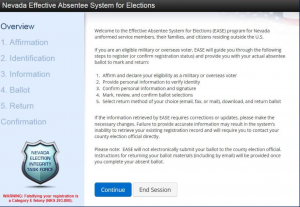
In House
In-House Remote Ballot Marking Systems and Internet Voting Systems
Make / Model: In-House Remote Ballot Marking Systems and Internet Voting Systems
Equipment Type: Remote Ballot Marking System or Internet Voting System
Back to Voting Equipment Database
Overview
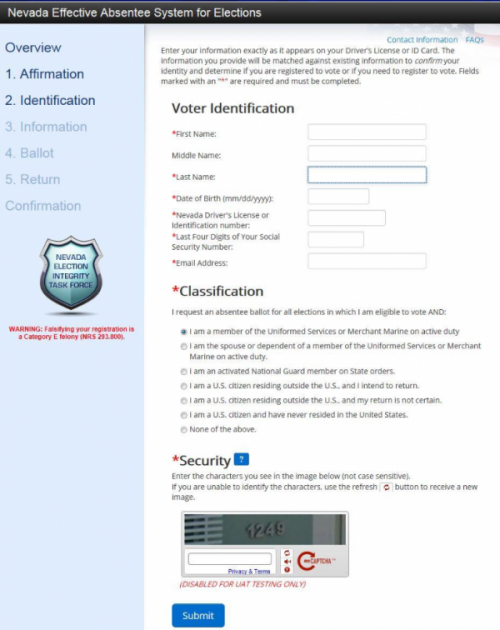
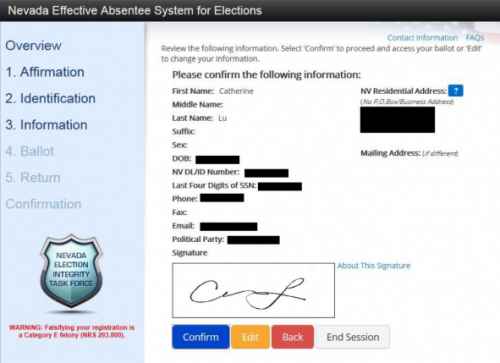
A handful of states offer in-house remote ballot marking systems to eligible voters. These systems are not designed and built by commercial companies; instead, they are developed in-house by a state and are specific to the state’s needs and election codes. In 2011, the Federal Voting Assistance Program (FVAP) first offered its Electronic Absentee System for Elections (EASE) grant program to fund research programs for online blank ballot delivery, online voter registration, online ballot requests, automated ballot duplication, and online ballot tracking to improve services for military and overseas voters. In 2013, the EASE program further provided funding for the development of online ballot delivery tools and the establishment of a single point of contact in state election offices.
In 2011, the Maryland State Board of Elections applied for an EASE grant to improve its existing online ballot delivery program, which had been in use for one year. Prior to 2010, the elections officials had created individual emails and manually attached the appropriate documents for each eligible voter. The 2011 grant was requested to create an online ballot marking wizard and the ability to print a QR code on the voter’s ballot that encodes the voter’s selections. The Board requested funding so that each local board of elections could purchase at least one ballot-on-demand printer capable of printing up to 18” ballots, at least one QR code scanner, and the appropriate software to print QR codes and convert them to human readable text. The Maryland system is available to all Maryland voters.
In 2011, North Dakota developed its own in-house remote ballot marking system for its Uniformed and Overseas Citizens Absentee Voting Act (UOCAVA) voters, who had been allowed to fax and email back their voted ballots. Through action of the Legislative Assembly, North Dakota expanded the voting process for these voters by allowing them to request ballots online, digitally mark their ballots, and electronically submit their ballots through an online portal (internet voting).
In 2011, the Louisiana Legislature passed Act 624 to implement the Military and Overseas Voter Empowerment (MOVE) Act for Louisiana’s military and overseas voters. The law was amended by Act 195 to allow these voters under certain circumstances to return voted ballots via fax. In 2013, Louisiana applied for and received an FVAP grant to test an online ballot marking tool for UOCAVA voters. Louisiana currently offers its UOCAVA voters a server-side remote ballot marking system, which they may use to access, print, and hand mark their ballots, or which they may use to electronically mark their ballots. However a Louisiana voter marks their ballot, they must return it by mail or drop off—or, in some instances, electronically.
The Missouri Secretary of State’s Office offers UOCAVA voters a website on which they can register to vote, request and receive an absentee ballot, and, for military members in a hostile zone, by which they can transmit their voted ballots (internet voting). Most voters are required to return their ballots by mail; however, in 2020, the Secretary of State declared that all overseas areas were inaccessible on Election Day during the primary election, and that any eligible voters serving or living overseas could return voted ballots via the portal.
In 2014, Nevada began offering its UOCAVA voters the Effective Absentee System For Elections (EASE), an online application for registering to vote, requesting and accessing a ballot, marking a ballot, and making an electronic signature. Assembly Bill 175, passed during the 2013 Legislature, authorized certain voters to make electronic signatures on applications to register to vote, on applications for military-overseas ballots, and on military-overseas ballots. In April 2020, EASE was made available to Nevada voters with disabilities and in 2023 the legislature expanded its use to voters who are tribal members who reside on a reservation. While EASE began as a server-side remote ballot marking system that creates a ballot which could be emailed, faxed, or mailed to the county clerk or registrar, it is now used as an internet voting system. The ballot must be duplicated by a bi-partisan team for scanning.
Voting Process
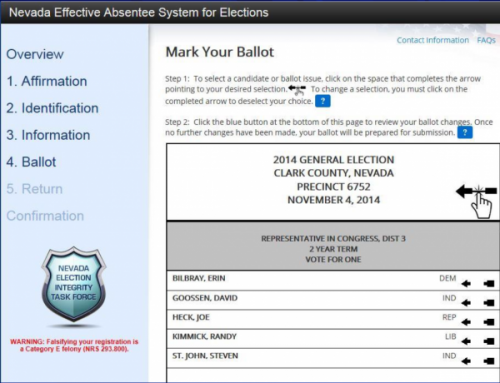
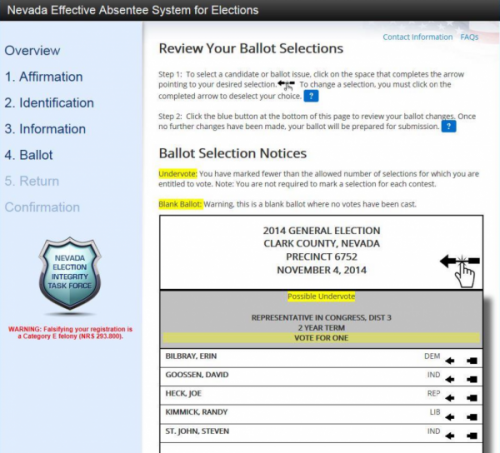
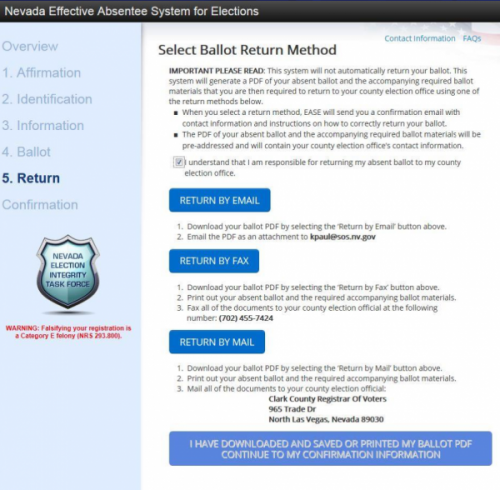
In North Dakota, voters are given the option to mark their ballots using the online tool printing and hand marking their ballot. Whether returned via mail, email, fax, or through the online portal (internet voting) the ballot is not scannable and must be recreated by two judges.
In Louisiana, voters may choose to download a PDF ballot from the Secretary of State’s website and mark it by hand or mark their ballots online. If a voter uses the server-side remote ballot marking tool, the voter has the chance to review their ballot, which they must then print and mail or drop off with their parish registrar of voters office. There are special provisions in Louisiana for UOCAVA voters during a time of declared emergency to return their ballots electronically; however, voters must contact their parish registrar of voters to understand their eligibility for this option.
Maryland Online Ballot Marking Tool
In Maryland, voters receive an email from the Maryland State Board of Elections with a link specific to each voter. The link directs the voter to Maryland’s Online Ballot Delivery, where the voter enters personally identifiable information, including first and last name, date of birth, and zip code. There is also a CAPTCHA on the page that the voter must complete. The voter then creates a username and password to access their ballot. The system is compatible with most screen readers. After the voter completes and reviews their ballot, the voter prints their ballot, they must also print and sign the voter oath. All of these documents are included in one envelope—supplied by the voter—and returned to the voter’s elections office.
A QR code is printed on the voter’s ballot that encodes the voter’s selections. Depending on the jurisdiction, the QR code may be used to duplicate the ballot or the ballot may be manually duplicated onto scannable ballot paper by a bipartisan team of election officials.
Nevada’s Effective Absentee System For Elections (EASE)
To vote using Nevada’s Effective Absentee System For Elections (EASE), voters access the system in their preferred web browser. The voter receives instructions and selects “Continue” to be taken to their affirmation page, where the voter must affirm their eligibility as a UOCAVA voter, voter with a disability, or voter who is a tribal member who resides on a reservation. The voter must select a check box and select “Submit.” On the identification page, the voter provides personally identifiable information, including their first and last name, date of birth, Nevada driver license or identification number, the last four digits of their Social Security Number (SSN), and their email address. The voter must also select what makes them eligible to use the system, complete a CAPTCHA security test, and select “Submit.”
The voter is taken to their personal information page, which presents their name, address, date of birth, Nevada driver license or identification number, last four digits of their SSN, phone number, email, preferred political party, and signature, which the county clerk or registrar has on file from the Nevada Department of Motor Vehicles. The voter selects “Edit” to make changes or “Confirm” if their information is correct. Throughout the voting process, the voter is notified that the system itself does not support the electronic return of their voted ballot (internet voting).
The voter is next taken to the ballot marking screen, which presents a traditional looking ballot. The voter is instructed to click on the space to complete the arrow pointing to their desired candidate. The voter marks their entire ballot on one page and then selects the button at the bottom of the page to review their selections. On this same screen, the voter is presented with undervote and overvote warnings, which appear highlighted in yellow, as do the directions regarding how many candidates may be selected per contest.
The voter is next provided the options for how to return their ballot: return by email or fax (internet voting), or return by mail or drop off. The voter must select a check box stating that they understand the system itself will not return their ballot. The voter selects their return option and downloads a PDF of their ballot. The voter is next presented with a cover sheet, which includes their system-generated electronic signature. The voter next selects that they have downloaded their PDF and receives a confirmation number.
References
Federal Voting Assistance Program (FVAP) Grant Programs
Nevada Effective Absentee System For Elections (EASE) Demonstration Slides
North Dakota UOCAVA Absentee Voting Process
Maryland State Board of Elections Technical Proposal for Single Point of Contact for Maryland’s UOCAVA Voters (2017)
Maryland State Board of Elections Addendum #3 to Technical Proposal for Online Voter Registration & Ballot Marking and Counting: An Adaptable and Open Source Solution (2013)
State of Louisiana, Louisiana MOVEs Forward Technical Proposal (2013)
Security Concerns
Electronic Return of Voted Ballots (Internet Voting) Supported
Every internet-connected system or device, including a remote ballot marking system that allows for the electronic return of voted ballots (internet voting), is vulnerable to attack. Internet voting systems do not provide a voter-verified paper record, which is the most reliable way to recover from an attack and check that the results were not tampered with. In their 2020 Security Analysis of the Democracy Live Online Voting System, Michael A. Specter and J. Alex Halderman, who did not review these in-house remote ballot marking systems, note that if a hacker interferes with a voter’s selections after they have submitted a ballot, the voter has no way to review their actual printed ballot and likewise has “no practical ability to detect vote-changing attacks involving online ballot return.” There is also currently no trustworthy way for a voter to ensure that somebody else did not vote in their name. Read more about internet voting here.
Unreadable Bar Codes and QR Codes
In their 2020 Security Analysis of the Democracy Live Online Voting System, Michael A. Specter and J. Alex Halderman, who did not review these in-house remote ballot marking systems, note that an attacker could “encode false votes within barcodes, so that the ballot appears (to a human) to be marked for the voter’s selected candidate but will be counted by an optical scanner as a vote for a different candidate.” Bar codes and QR codes are not readable by humans and, as Specter and Halderman point out, the summary ballot could appear to the voter to be the same selections the voter made; however, when remade onto scannable ballot stock, the bar code or QR code could transpose the voter’s actual selections for those of the hacker’s choice.
Server-Side Connections
In their 2020 Security Analysis of the Democracy Live Online Voting System, Michael A. Specter and J. Alex Halderman note that when server-side web apps send a voter’s identity and ballot choices to a remote server to generate a marked ballot PDF file, an attacker could learn voters’ ballot selections. For those voters using the in-house remote ballot systems that do not support the electronic return of voted ballots (internet voting), a review of the printed ballot should allow the voter to catch any interference—except if an attacker alter’s a QR code, which the voter cannot read without a QR code scanner. Specter and Halderman have not reviewed the above described in-house systems; however, they note that marking ballots server-side increases risks to election integrity and ballot secrecy.